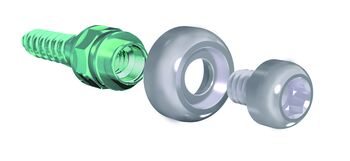The OrthoEasy® system from FORESTADENT has proven itself throughout the years as a reliable solution for skeletal anchoring tasks. In order to enable the orthodontist to work effectively with minimal initial investment, this system includes just four screw versions and a few insertion tools, which can be used to cover all treatment variations.
Mini implants with double cross slot head (.022" x .025") in a bracket design are available for vestibular insertion. These are available in the colour-coded lengths of 6 mm (rosé), 8 mm (pink), and 10 mm (gold). The OrthoEasy® Pal Pin has been especially developed for anchoring laboratory-fabricated orthodontic appliances in the palate. It is available in a length of 8 mm, which is ideally suited to palatal insertion. The head of the OrthoEasy® Pal Pin is equipped with an internal thread. This allows the therapy devices (e.g. for RPE/RME or distalization / mesialization), which have been welded to insertable abutments in advance, to be easily attached to the head of the pins using a retaining screw.
New OrthoEasy® accessories available
FORESTADENT now offers abutments for the palatal pin in a significantly flatter design to ensure even simpler positioning of the orthodontic appliance for the practitioner. In addition, the company expands the accessories to cover the use of its vestibular OrthoEasy® mini implants. Three new fastening plates (parallel or rectangular wire and T-shaped) are available alongside a new fastening element for distalization/mesialization.
Precise, template-guided insertion with Accuguide
In addition, FORESTADENT is now able to order three-dimensional printed insertion templates for guided, high-precision insertion of OrthoEasy® Pal Pins into the palate. This new service is known as Accuguide and involves the dentist uploading the patient data through a portal (www.forestadent-portal.com), determining the therapy goal and, after approving a corresponding mini-screw positioning proposal, receiving the 3D-printed working model for manufacturing the appliance as well as the 3D-printed insertion template. Using the available working model as a basis, the surgery’s laboratory or laboratory partner can now produce the intended appliance with the OrthoEasy® Pal mini screws.
The pins can then be precisely inserted into the palate using the individual Accuguide insertion template for guiding support. As scientific developments stand at present, the entire process from taking the X-rays or scans to insertion should last no longer than four to five weeks.

